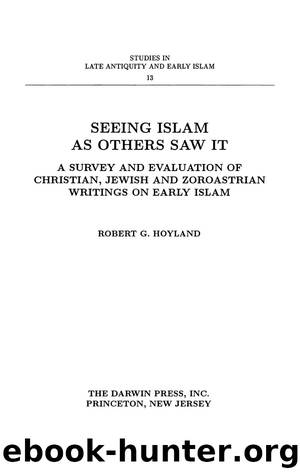Seeing Islam as Others Saw It: A Survey and Evaluation of Christian, Jewish and Zoroastrian Writings on Early Islam by Robert G. Hoyland

Author:Robert G. Hoyland
Language: eng
Format: epub
ISBN: 0878501258
Publisher: eBooks2go, Inc.
CHAPTER 11
APOLOGIES AND DISPUTATIONS
IN A TREATISE aiming to demonstrate that Christianity is the true religion, the Melkite theologian Theodore Abū Qurra (d. ca. 820s) introduces a small thought-experiment:
Let’s say that I grew up on a mountain ignorant of the nature of people and one day, on account of some need that presented itself to me, I went down to the cities and to the society of people, and I perceived them to be of different religions…(Theodore reviews the nine principal creeds of his day)….Reflecting on the doctrine of each one of them, I perceived all of them to be in agreement on three points and in disagreement about them too. As for their agreement, all bar one or two claimed to have a god, to have permitted and forbidden things, and also reward and punishment. As for their disagreement, they differ on the characteristics of their gods, the things permitted and forbidden, and [the nature of] the reward and punishment.
I reflected again and said [to myself]: It befits God, in his goodness and grace, when he perceived that his creation had deviated from the worship of truth, that he send to them a messenger and a book to make them realise that and to return them to it from their errors. But there came a plurality of messengers and books.. .It is appropriate that there should be among them [only] one [true one] in accordance with what is known of God’s grace and providence for his creation, but what is the trick for recognising this one?1
Two younger contemporaries of Theodore, the Muslim writer Jāḥiẓ and the Jewish theologian Dāwūd ibn Marwān al-Muqammiṣ, also posed themselves this question.2 The former, in his essay Fī ḥujaj al-nubūwa (“On the Proofs of Prophecy”), postulates two categories of proofs: those pertaining to sensory perception (‘iyān ẓāhir) and those based upon a cogent tradition (khabar qāhir), both cases requiring the involvement of the intellect for purposes of verification. The most important sensory experience in the determination of prophethood was a miracle performed by the contender:
The signs of messengers, peace be upon them, and their miracles are more worthy of attention and renown and [of being considered] a compelling [argument] for hearts and minds than their preaching and their laws. Indeed, we know that Moses, peace be upon him, was unknown and of no repute except on account of his wonders and miracles, and the same is true of Jesus, peace be upon him. Were it not for that, they would have been just like the rest whose death and birth pass unnoticed.3
For Muqammiṣ, too, the execution of miracles was a prerequisite for belief in a prophet, and he further stipulated that the content of the prophecy must be in accord with logic and common sense, and that “the tradition about him should not come from one direction, but rather from several quarters. .nor from one nation and in [only] one language.”4
These three works illustrate very well two salient characteristics of the polemic conducted by Christians, Jews and Muslims in the eighth to tenth centuries.
Download
This site does not store any files on its server. We only index and link to content provided by other sites. Please contact the content providers to delete copyright contents if any and email us, we'll remove relevant links or contents immediately.
The Vikings: Conquering England, France, and Ireland by Wernick Robert(77270)
Ali Pasha, Lion of Ioannina by Eugenia Russell & Eugenia Russell(39309)
The Vikings: Discoverers of a New World by Wernick Robert(36478)
Cecilia; Or, Memoirs of an Heiress — Volume 1 by Fanny Burney(31322)
Cecilia; Or, Memoirs of an Heiress — Volume 3 by Fanny Burney(30928)
Cecilia; Or, Memoirs of an Heiress — Volume 2 by Fanny Burney(30885)
The Conquerors (The Winning of America Series Book 3) by Eckert Allan W(27550)
Empire of the Sikhs by Patwant Singh(22163)
The Secret History by Donna Tartt(16608)
Hans Sturm: A Soldier's Odyssey on the Eastern Front by Gordon Williamson(16569)
Cat's cradle by Kurt Vonnegut(13855)
Sapiens: A Brief History of Humankind by Yuval Noah Harari(13037)
Pimp by Iceberg Slim(12922)
Leonardo da Vinci by Walter Isaacson(11895)
Norse Mythology by Gaiman Neil(11873)
Talking to Strangers by Malcolm Gladwell(11861)
Underground: A Human History of the Worlds Beneath Our Feet by Will Hunt(11251)
4 3 2 1: A Novel by Paul Auster(11033)
The Radium Girls by Kate Moore(10901)
